Best Market Performer of 2012 So Far
Since
the stock market’s gate opened at the beginning of 2012, emerging countries were
off to a fast start. Stocks in Brazil, Colombia and India galloped to the lead,
increasing more than 10 percent within the first few weeks of the
year.
By the time the end of
April came around, Colombia had sprinted to the lead, followed closely by
Thailand and the Philippines. All increased more than 20 percent in the first
four months of 2012.
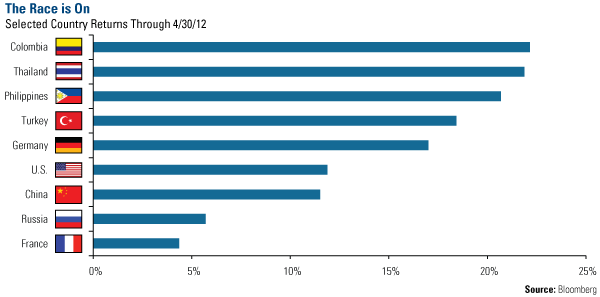
However,
rather than focusing on the leaders of the pack, spectators seemed to have
directed their attention toward the S&P 500 Index, as it galloped to its
best first-quarter gain since 1998.
The
recovery in U.S. stocks is significant and helps restore confidence in equities.
We’re pleased to see markets improving, especially following a rough finish in
2011. Yet there lingers a persistent negativity toward emerging markets growth
and commodities that prevents many investors from jockeying their portfolios
into a position for growth. Rather, they remain spectators on the sidelines,
with equity fund outflows continuing.
In
contrast, Eastern Europe exploded on the upside and far outpaced not only the
U.S. market, but also Europe. The chart below shows investment results across
three different markets. Since the beginning of the year through April 30, the
iShares S&P Europe 350 ETF has trailed, while the SPDR S&P 500 ETF has
placed second.
Among
these three investments, the Eastern European Fund (EUROX) has kept the lead for
most of the quarter and took first place as of April 30.
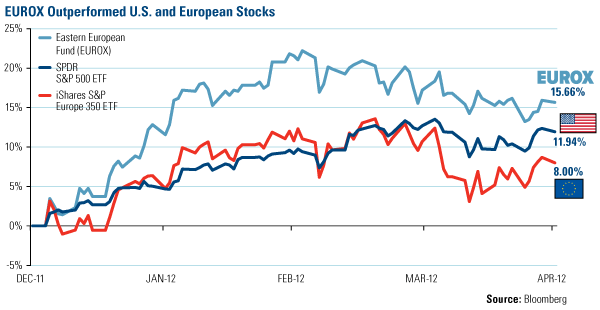
You
can see above that EUROX and the European market were climbing steadily since
the beginning of the year, but by April, began to fall because of the eurozone’s
debt grief and concerns over China.
Over
the past four months, Russian stocks, which are heavily weighted in energy
companies, have underperformed many emerging markets, increasing only about 6
percent. HSBC Global Research believes that the low valuations seem to be
“pricing in a lot of political risk” surrounding the protests against Russia’s
newly elected presidential candidate. Investors need to see the opposition
movements against Vladimir Putin as very different from the Middle East
discontent, says HSBC. The firm says Russia’s protests are “largely liberal”
without “religious dimension” which suggest future reforms to reduce the
political discontent are more likely.
HSBC
also thinks that the government will try to improve the investment climate.
Putin suggested in a recent speech that he would like to increase Russia’s
rating in the World Bank’s Ease of Doing Business report. Currently, Russia
ranks 120th; Putin would like to set a goal of 20th place.
What
may be hurting investor sentiment toward Russia in the short term is the
political strain that has recently surfaced between Russia and the U.S. and NATO
involving missile defense installations in Europe. This is precisely the reason
we believe investors need to hold actively managed investments with experts who
understand the political situation to skillfully maneuver around emerging
Europe.
China,
the Workhorse of the Global Economy
While
China did not win, place or show among major markets during the first few months
of the year, its H shares gained nearly as much as the S&P 500. Yet, the
negativity that I’ve frequently discussed continues, even though the country
is the Clydesdale of our global economy.
In
the first quarter, China’s GDP growth was 8.1 percent, a likely trough for the
year, according to a Merrill Lynch-Bank of America conference call recently. The
firm listed several reasons that China will see an improved GDP over the next
three quarters:
- Although spring made an early appearance in many parts of North America, this past winter in China was the coldest in 27 years. This extremely chilly weather slowed down economic activity.
- Credit growth has bottomed out and bank lending has been reaccelerating. BCA Research echoed this thought in its China Investment Strategy this week, saying there’s been a “sharp turnaround in bankers’ confidence in recent months, which is also being reflected in rising bank lending of late.”
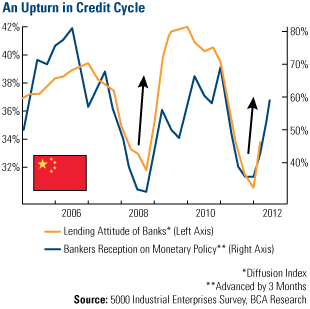 Home developer price cuts and lower mortgage rates offered
to first-time buyers have driven a significant recovery in home sales. In our recent
webcast on China, Andy Rothman from CLSA made some excellent comments
related to mortgages, agreeing with ML-BofA, saying that each month it was
getting easier for new home buyers to get mortgages, and along with lower
interest rates for mortgages, this was a clear sign of “the government’s process
of easing up on the housing sector.”
Home developer price cuts and lower mortgage rates offered
to first-time buyers have driven a significant recovery in home sales. In our recent
webcast on China, Andy Rothman from CLSA made some excellent comments
related to mortgages, agreeing with ML-BofA, saying that each month it was
getting easier for new home buyers to get mortgages, and along with lower
interest rates for mortgages, this was a clear sign of “the government’s process
of easing up on the housing sector.”
- With leadership transition close to conclusion, local infrastructure construction activity is poised to increase.
- As shown below, crude steel, steel products and cement output has shown initial signs of recovery in the recent month.
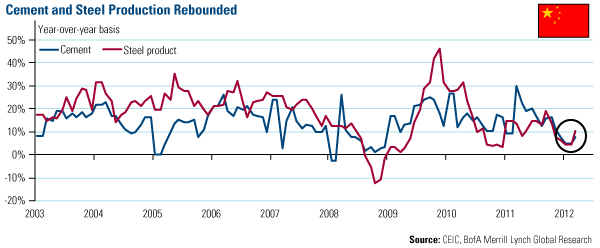
While
China’s Government Purchasing Managers’ Index (PMI) for April came in slightly
below market consensus, the number remains above the three-month number for the
fifth consecutive month since December 2011. We believe the government’s PMI is
a far better indicator of overall manufacturing activity than the HSBC data
because it takes into account domestic demand.
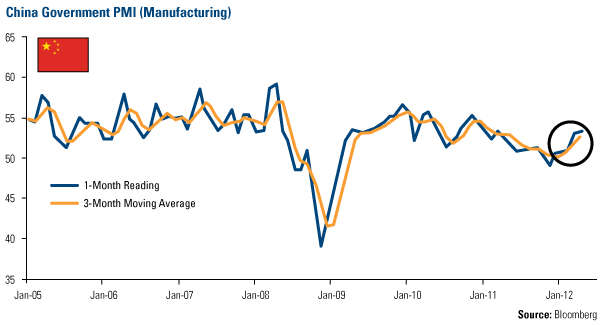
From
the PMI’s inception in January 2005, the majority of the time the PMI is above
the three-month average, Chinese and U.S. stocks, as well as copper and WTI
crude oil, all see gains over the following three months. So far this year, each
has proved true.
BCA
Research says that the latest PMI substantiates that the “Chinese economy may be
reaccelerating,” pointing to three trends: Monetary easing is working, external
demand seems strong and may be accelerating, and the government has increased
fiscal expenditures on social housing and infrastructure projects, which is
supportive of ML-BofA’s view above.
The
race in the stock market isn’t over until it’s over. While a top
contender may ultimately win in the Run for the Roses, the assumed “long shot”
might come from behind and race to first place. Rather than place all your money
on the market you believe will win, place or show, we believe diversification
among markets is the way to go.

No comments:
Post a Comment